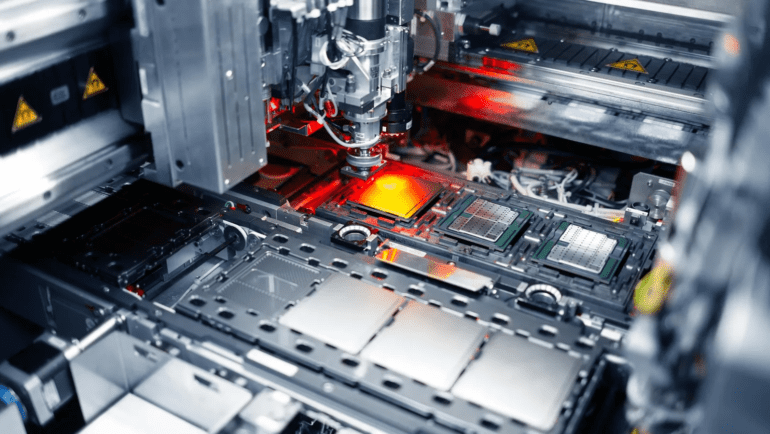TL;DR:
- Intel announces a strategic reboot, focusing on expanding its foundry business for chip designs.
- Microsoft pledges to utilize Intel’s revamped foundry for future chip productions, marking a significant endorsement.
- Intel unveils the groundbreaking 18A manufacturing process, poised to rival industry leaders like TSMC.
- CEO Pat Gelsinger aims for Intel to become the world’s second-largest foundry by 2030.
- Intel’s resurgence strategy capitalizes on the surge of generative AI, targeting dominance in AI chip manufacturing.
- The success of Intel’s revitalization is pivotal for the US tech industry’s ambitions in AI and semiconductor leadership.
Main AI News:
Intel, once the titan of the tech realm, is staging a remarkable resurgence—one that carries profound implications not just for its own future, but for the broader aspirations of the United States government in maintaining supremacy in artificial intelligence. In a groundbreaking announcement, Pat Gelsinger, CEO of the embattled chipmaker, unveiled plans for a sweeping revitalization and expansion of its foundry business, tasked with fabricating chip designs for external entities.
The significance of this move was underscored by the presence of Microsoft CEO Satya Nadella at the Intel event, where he disclosed Microsoft’s intention to leverage Intel’s revamped foundry for its upcoming chip productions. This collaboration signifies a major triumph for Intel as it endeavors to reclaim relevance in the global semiconductor landscape, currently dominated by Taiwan’s TSMC, renowned for servicing tech giants like Apple and Google.
“We are poised to meet the escalating demand for cutting-edge semiconductors,” remarked Nadella, expressing Microsoft’s enthusiasm for partnering with Intel’s foundry services. Microsoft’s chips are slated to roll out utilizing Intel’s groundbreaking 18A manufacturing process, which is slated for release later this year. Intel asserts that the 18A process will rival the pinnacle of technological prowess offered by its foremost competitors, TSMC and Samsung.
Gelsinger elucidated that the development of the 18A process culminated in two years of relentless innovation, compressing advancements that would typically span a decade. He articulated Intel’s ambition to ascend to the rank of the world’s second-largest foundry by 2030, a title currently held by TSMC.
Strategic Imperative
Intel’s pivot towards foundry operations is a strategic maneuver aimed at harnessing the burgeoning wave of generative AI to rejuvenate a company that has experienced a gradual erosion of its once-dominant position in the technology sphere. Having faltered in recognizing the primacy of mobile computing and forfeiting its manufacturing supremacy by eschewing cutting-edge lithography techniques, Intel found itself eclipsed by competitors like Nvidia in the domain of AI-centric chipsets.
Gelsinger, however, remains resolute in his conviction that Intel can reclaim its stature, buoyed by the expansive frontier of AI. At the heart of this vision lies Intel’s aspiration to become the preeminent supplier of AI chips, leveraging its reinvigorated foundry capabilities.
The efficacy of Intel’s resurgence strategy holds pivotal implications not just for the company itself, but for the broader ambitions of the US tech ecosystem and governmental agendas pertaining to AI and semiconductor leadership.
Gina Raimondo, US Secretary of Commerce, drew parallels between the current imperative to revitalize the domestic chip industry and the fervor of the 1960s space race. Emphasizing the imperative of reducing dependency on foreign entities for critical technologies, Raimondo articulated the pressing need for domestic chip production.
Transparent Transformation
Intel’s newfound focus on its foundry endeavors extends to a commitment to transparency, with plans to segregate the financial performance of this segment for investor scrutiny. “We are not merely refurbishing a single entity; we are birthing two vibrant organizations,” affirmed Gelsinger.
As Intel charts its course toward resurgence, securing the trust of prospective clientele emerges as a paramount objective. Industry pundits, cautiously optimistic, perceive Intel’s revamped foundry strategy as a departure from prior endeavors, showcasing a more discernible trajectory toward success.
Dan Hutcheson, a seasoned analyst in the semiconductor domain, acknowledges Intel’s strides under Gelsinger’s leadership, noting a perceptible uptick in market understanding and customer acquisition.
Gelsinger’s assumption of Intel’s helm in 2021 heralded a paradigm shift for the company, marked by an aggressive revival blueprint encompassing indigenous chip development, engineering prowess, and collaborative foundry ventures.
In the dynamic landscape of semiconductor innovation, Intel’s resurgence signifies not merely a corporate turnaround, but a harbinger of transformative potential for the US semiconductor ecosystem, underpinned by the fusion of technological ingenuity and strategic foresight.
Conclusion:
Intel’s ambitious pivot towards revitalizing its foundry business and leveraging generative AI signifies a seismic shift in the semiconductor landscape. With strategic endorsements from industry behemoths like Microsoft and a bold vision outlined by CEO Pat Gelsinger, Intel is poised to reclaim its prominence. This resurgence not only heralds a potential renaissance for Intel but also underpins the broader aspirations of the US tech ecosystem in fostering innovation and reclaiming semiconductor leadership on the global stage.

